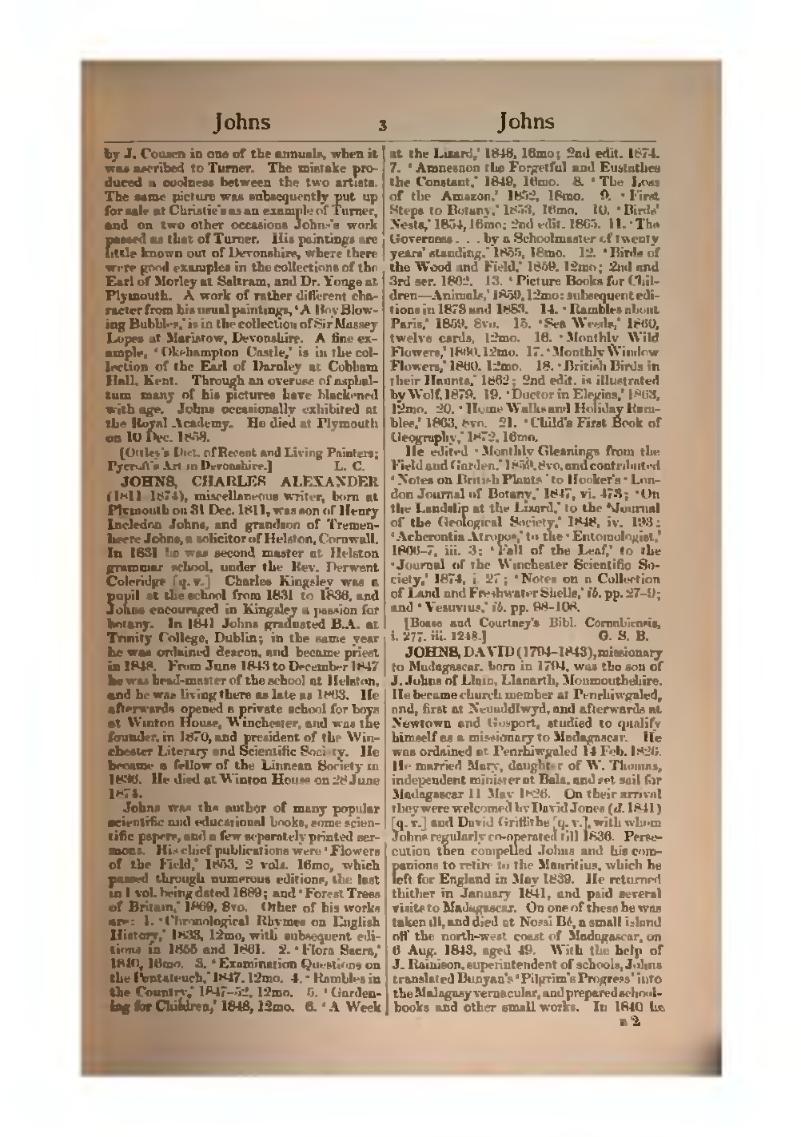by J. Cousen in one of the annuals, when it was ascribed to Turner. The mistake produced a coolness between the two artists. The same picture was subsequently put up for sale at Christie's as an example of Turner, and on two other occasions Johns's work passed as that of Turner. His paintings are little known out of Devonshire, where there were good examples in the collections of the Earl of Morley at Saltram, and Dr. Yonge at Plymouth. A work of rather different character from his usual paintings, ‘A Boy Blowing Bubbles,’ is in the collection of Sir Massey Lopes at Maristow, Devonshire. A fine example, ‘Okehampton Castle,’ is in the collection of the Earl of Darnley at Cobham Hall, Kent. Through an overuse of asphaltum many of his pictures have blackened with age. Johns occasionally exhibited at the Royal Academy. He died at Plymouth on 10 Dec. 1858.
[Ottley's Dict. of Recent and Living Painters; Pycroft's Art in Devonshire.]
JOHNS, CHARLES ALEXANDER (1811–1874), miscellaneous writer, born at Plymouth on 31 Dec. 1811, was son of Henry Incledon Johns, and grandson of Tremenheere Johns, a solicitor of Helston, Cornwall. In 1831 he was second master at Helston grammar school, under the Rev. Derwent Coleridge [q. v.] Charles Kingsley was a pupil at the school from 1831 to 1836, and Johns encouraged in Kingsley a passion for botany. In 1841 Johns graduated B.A. at Trinity College, Dublin; in the same year he was ordained deacon, and became priest in 1848. From June 1843 to December 1847 he was head-master of the school at Helston, and he was living there as late as 1863. He afterwards opened a private school for boys at Winton House, Winchester, and was the founder, in 1870, and president of the Winchester Literary and Scientific Society. He became a fellow of the Linnean Society in 1836. He died at Winton House on 28 June 1874.
Johns was the author of many popular scientific and educational books, some scientific papers, and a few separately printed sermons. His chief publications were ‘Flowers of the Field,’ 1853, 2 vols. 16mo, which passed through numerous editions, the last in 1 vol. being dated 1889; and ‘Forest Trees of Britain,’ 1869, 8vo. Other of his works are: 1. ‘Chronological Rhymes on English History,’ 1833, 12mo, with subsequent editions in 1855 and 1861. 2. ‘Flora Sacra,’ 1840, 16mo. 3. ‘Examination Questions on the Pentateuch,’ 1847, 12mo. 4. ‘Rambles in the Country,’ 1847–52, 12mo. 5. ‘Gardening for Children,’ 1848, 12mo. 6. ‘A Week at the Lizard,’ 1848, 16mo; 2nd edit. 1874. 7. ‘Amnesnon the Forgetful and Eustathes the Constant,’ 1849, 16mo. 8. ‘The Loss of the Amazon,’ 1852, 18mo. 9. ‘First Steps to Botany,’ 1853, 16mo. 10. ‘Birds' Nests,’ 1854, 16mo; 2nd edit. 1865. 11. ‘The Governess … by a Schoolmaster of twenty years' standing,’ 1855, 18mo. 12. ‘Birds of the Wood and Field,’ 1859, 12mo; 2nd and 3rd ser. 1862. 13. ‘Picture Books for Children—Animals,’ 1859, 12mo; subsequent editions in 1873 and 1883. 14. ‘Rambles about Paris,’ 1859, 8vo. 15. ‘Sea Weeds,’ 1860, twelve cards, 12mo. 16. ‘Monthly Wild Flowers,’ 1860, 12mo. 17. ‘Monthly Window Flowers,’ 1860, 12mo. 18. ‘British Birds in their Haunts,’ 1862; 2nd edit. is illustrated by Wolf, 1879. 19. ‘Ductor in Elegias,’ 1863, 12mo. 20. ‘Home Walks and Holiday Rambles,’ 1863, 8vo. 21. ‘Child's First Book of Geography,’ 1872, 16mo.
He edited ‘Monthly Gleanings from the Field and Garden,’ 1859, 8vo, and contributed ‘Notes on British Plants’ to Hooker's ‘London Journal of Botany,’ 1847, vi. 473; ‘On the Landslip at the Lizard,’ to the ‘Journal of the Geological Society,’ 1848, iv. 193; ‘Acherontia Atropos,’ to the ‘Entomologist,’ 1866–7, iii. 3; ‘Fall of the Leaf,’ to the ‘Journal of the Winchester Scientific Society,’ 1874, i. 27; ‘Notes on a Collection of Land and Freshwater Shells,’ ib. pp. 27–9; and ‘Vesuvius,’ ib. pp. 98–108.
[Boase and Courtney's Bibl. Cornubiensis, i. 277, iii. 1248.]
JOHNS, DAVID (1794–1843), missionary to Madagascar, born in 1794, was the son of J. Johns of Llain, Llanarth, Monmouthshire. He became church member at Penrhiwgaled, and, first at Neuaddlwyd, and afterwards at Newtown and Gosport, studied to qualify himself as a missionary to Madagascar. He was ordained at Penrhiwgaled 14 Feb. 1826. He married Mary, daughter of W. Thomas, independent minister at Bala, and set sail for Madagascar 11 May 1826. On their arrival they were welcomed by David Jones (d. 1841) [q. v.] and David Griffiths [q. v.], with whom Johns regularly co-operated till 1836. Persecution then compelled Johns and his companions to retire to the Mauritius, which he left for England in May 1839. He returned thither in January 1841, and paid several visits to Madagascar. On one of these he was taken ill, and died at Nossi Bé, a small island off the north-west coast of Madagascar, on 6 Aug. 1843, aged 49. With the help of J. Rainison, superintendent of schools, Johns translated Bunyan's ‘Pilgrim's Progress’ into the Malagasy vernacular, and prepared school-books and other small works. In 1840 he
